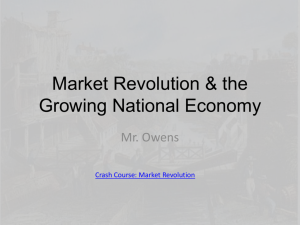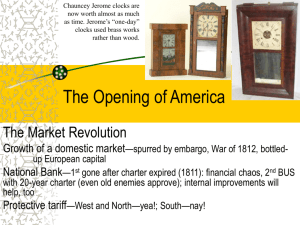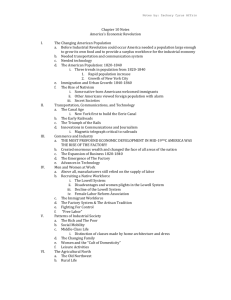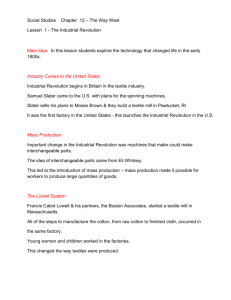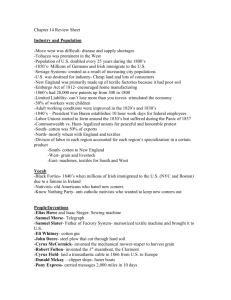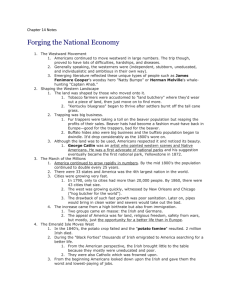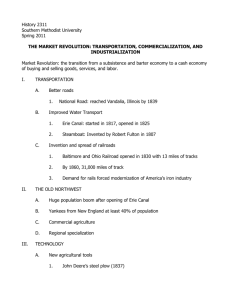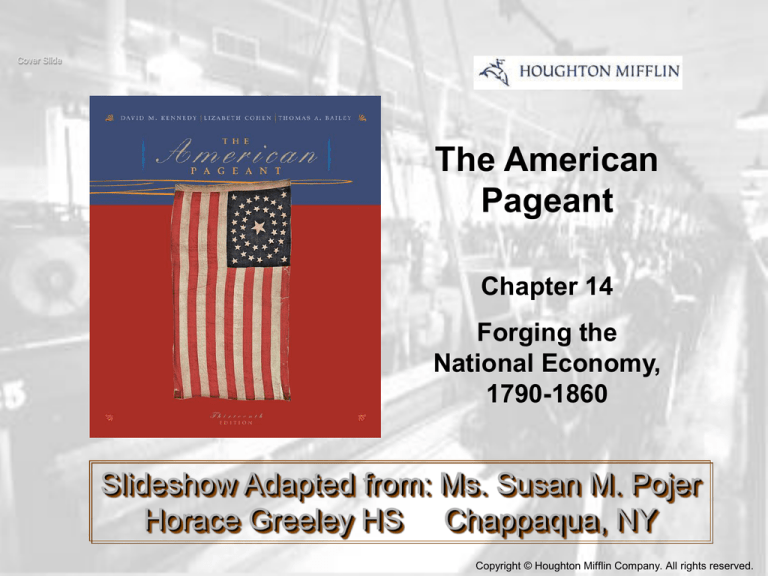
Cover Slide
The American
Pageant
Chapter 14
Forging the
National Economy,
1790-1860
Slideshow Adapted from: Ms. Susan M. Pojer
Horace Greeley HS Chappaqua, NY
Copyright © Houghton Mifflin Company. All rights reserved.
The Westward Movement
• U.S. marched quickly toward the West
– proved to be very hard with disease &
loneliness
• Frontier people =
– Individualistic
– Superstitious
– ill-informed of current matters
Shaping the Western Landscape
• Westward movement molds the
environment
• Tobacco overuse
exhausted the land
– settlers forced to move on
• Settlers trapped beavers, sea otters, &
bison for fur to ship back East.
• Nationalism
an appreciation of the
American wilderness
– Artist George Catlin pushed for national parks
• achieved it with Yellowstone in 1872.
The March of the Millions
• mid-1800s- population continues to 2X every 25 yrs.
– By 1860:
• 33 states
• American population = 4th in world (behind Russia, France, Austria).
• Urban growth continued explosively.
– In 1790, only New York & Philadelphia had 20,000+ people
• by 1860, 43 cities had
• Problems?
– poor sanitation,(later sewage systems & piped-in water
came about)
The March of the Millions
• high birthrate = population growth
• ~1850s, millions of Irish & German came.
– why come to US?
•
•
•
•
•
surplus population in Europe
Land
freedom from church
no aristocracy
3 meat meals a day.
• transoceanic steamships were used
– travel time dropped to 12 days & it was safer.
The Emerald Isle Moves West
• Irish potato famine (mid-1840s“Black Forties”)
– death of 2 million
– many flee to the U.S
• mainly came to cities like Boston & New York (biggest
Irish city)
• were illiterate, discriminated against by older
Americans, & received lowest-paying jobs
(railroad-building).
• were hated by Protestants because they’re
Catholic.
The Emerald Isle Moves West
• Americans hated the Irish (such as “NINA”—
No Irish Need Apply)
– Irish hated competition with blacks for the
low-paying jobs.
• The Ancient Order of Hibernians was
established to aid the Irish.
• Gradual property ownership came about, &
their children earned education.
• Irish-- attracted to politics
– often filled police departments as officers
American View of the Irish Immigrant
The German Forty-Eighters
• 1 million came in 1830s-1860s, why?
– crop failures & revolution/war of 1848.
– had more $ than the Irish,
• they bought land in West, esp. in Wisconsin.
– Votes = crucial
• were wooed by U.S. politicians
• *** lacked potency because were spread out.
The German Forty-Eighters
• contributed to the U.S. culture (i.e. the
Christmas tree) and isolationism.
– urged public education (started kindergarten)
– Advocated for freedom (were enemies of
slavery).
• faced resent from old Americans
– Ger. grouped themselves together
– Seen as aloof
– clung to their old ways
– kept speaking German language & religion,
– brought beer to the U.S
Flare-ups of Antiforeignism
• “nativists” – older Americans who were
prejudiced against newcomers in jobs, politics,
and religion
– Catholicism became a major faith
• due to the immigration of the 1840s-50s
• set out to build Catholic schools
• nativists feared that Catholicism challenged
Protestantism
– (Popish idols) so they formed the “Order of StarSpangled Banner” AKA, “The Know-Nothings”
• met in secrecy - “I Know-Nothing” = their response to
questions
•
Flare-ups
of
Antiforeignism
Nativists:
– Wanted restrictions on immigration, naturalization
– deportation of alien paupers
– wrote fiction books about corruption of churches
• Violence:
– i.e. Philadelphia (1844):
• burnt churches, schools, and people killed
• Immigration made America a pluralistic
society with diversity
– as time passed, immigrants = less disliked
• crucial to economic expansion & more jobs were
becoming available (although they were low-paying)
National Origin of Immigrants:
1820 - 1860
Why now?
KnowNothing
Party:
“The Supreme
Order of the
Star-Spangled
Banner”
Creeping Mechanization
• U.S. destined to become an industrial giant
– land = cheap
– $ for investment plentiful
– raw materials = plentiful
• Britain
– lacked consumers for factory-scale manufacturing
– America had the growing numbers
– long-established factory system was in competition with
the infant U.S. industries
– kept textile industry secrets as a monopoly (forbade travel
of craftsmen & export of machines)
• U.S. remains very rural & = mostly a farming nation
Whitney Ends the Fiber Famine
• Samuel Slater – “Father of the Factory
System”
– learned of textile machinery when working in
British factory
– escaped to U.S., aided by Moses Brown and
builds1st cotton thread spinner in the U.S.
(1791)
Samuel
Slater’s
Spinning
Frame
(p. 289)
•Slater’s frame for spinning wool was powered by
water and could spin thread simultaneously onto
96 bobbins (48 on each side of the lower part of
the machine). The introduction of the spinning
frame revolutionized textile manufacturing
dramatically increasing output
Whitney Ends the Fiber Famine
• Eli Whitney
– built a cotton gin (which was 50X more effective than
separating cotton seed by hand)
– cotton economics now = profitable & saved the South (“King
Cotton”)
– South flourished & expanded the cotton kingdom westward
– Northern factories manufactured textiles (cloth), especially in
New England, which had:
•
•
•
•
poor soil
dense labor
access to sea
Fast rivers for water power)
Eli Whitney’s Cotton Gin, 1791
Actually invented
by a slave!
Map 10.1
New
England’s
Dominance
in Cotton
Spinning,
1840
(p. 288)
South grew the
cotton & New
England used
their
waterpower to
spin the cotton
Marvels in Manufacturing
• Embargo Act of the War of 1812 encouraged
home manufacturing
– after the war:
• GB sent a surplus of cheap goods,
• many American factories closed (could not
compete with long-established British companies)
• Congress then passed Tariff of 1816 to protect
U.S. economy
• Eli Whitney introduced machine-made interchangeable parts (on muskets) - 1850
– = base of the assembly line - flourished in the North
– cotton gin flourished South
Eli Whitney’s Gun Factory
Interchangeable Parts Rifle
Marvels in Manufacturing
• Elias Howe & Issac Singer (1846) – the
sewing machine (the foundation of clothing
industry)
• 1860s had 28,000 patents
– 1800 only had 306
• Principle of limited liability in a corporation
(can’t lose more than invested) stimulated
the economy
• Samuel Morse’s telegraph connects the
business world
Elias Howe & Isaac Singer
1840s
Sewing Machine
Samuel F. B. Morse
1840 – Telegraph
Workers and “Wage Slaves”
• Factory system
• Owners benefitted
impersonal relations
– hours = long
– wages low
– conditions unsafe & unhealthy
– no unions existed to address these issues
• child labor = heavy
– 50% of the industrial labor force = children
Workers and “Wage Slaves”
• adult working conditions improve 1820s & 30s
–
–
–
–
–
mass vote given to workers
10 hour day
higher wages
public education
ban of imprisonment for debt
• 1840s
– President Van Buren est. 10 hour day for fed.
employees
• Were strikes
– Most lost because employers imported more workers
(the much-hated immigrants)
Workers and “Wage Slaves”
• labor unions (1830s) were hit by Panic of
1837
– Commonwealth v. Hunt
• Massachusetts Supreme Court (1842) legalized
unions for peaceful and honorable protest
• Effectiveness of unions was small
– mostly because threat of a strike was always
undermined
– Management could call in “scabs”
• were plentiful immigrants eager to work
Women and the Economy
• women toiled in factories under poor
conditions
• Lowell, Massachusetts
– model textile mill
– employed young, single
• opportunities were rare
• women worked in nursing, domestic service,
teaching (encouraged by Catharine
Beecher)
The Waltham plan:
•Recruited farm women & girls
as textile workers who would
work for low wages.
–Women often found this
work oppressive
–Many women gained a new
sense of freedom &
autonomy
–By combining improved
technology, female labor, &
tariff protection, the Boston
Manufacturing Company
sold textiles more cheaply
than did the British
Mill Girl, c.
1850 (p. 290)
Women and the Economy
•
•
•
•
•
•
•
women usually worked before marriage
after marriage became housewives & mothers
arranged marriages decrease
marriages due to love tied family closer
families grew smaller (average of 6)
fertility rate dropped sharply
“domestic feminism” was a crude form of
birth control
Women and the Economy
• child-centered families emerged with less
children & discipline
• home changed from a place of labor
– Now a place of refuge & rest from labor at the
mill
• women were in charge of family
• small, affectionate, child-centered families
Lowell in 1850
Lowell Mill
Early Textile Mill Loom Floor
New England
Textile
Centers:
1830s
The Lowell/Waltham System:
First Dual-Purpose Textile Plant
Francis Cabot Lowell’s town - 1814
New England Dominance in
Textiles
Starting for Lowell
Lowell Girls
What was their typical “profile?”
Lowell Boarding Houses
What was boardinghouse life like?
Lowell Mills
Time Table
Early
“Union”
Newsletter
The Factory Girl’s Garland
February 20, 1845 issue.
I’m a Factory Girl Filled with Wishes
I'm a factory girl
Everyday filled with fear
From breathing in the poison air
Wishing for windows!
I'm a factory girl
Tired from the 13 hours of wok each day
And we have such low pay
Wishing for shorten work times!
I'm a factory girl
Never having enough time to eat
Nor to rest my feet
Wishing for more free time!
I'm a factory girl
Sick of all this harsh conditions
Making me want to sign the petition!
So do what I ask for because I am a factory girl
And I'm hereby speaking for all the rest!
Irish Immigrant Girls at Lowell
Western Farmers Reap a
Revolution in the Fields
• the trans-Allegheny region (Ohio-IndianaIllinois) became the nation’s breadbasket
– planted corn and raised hogs
– Cincinnati =“the porkopolis” of the west
• inventions that boomed agriculture
– John Deere – invented the steel plow that cut
through hard soil and could be pulled by
horses
– Cyrus McCormick – invented the mechanical
mower-reaper to harvest grain
Western Farmers Reap a
Revolution in the Fields
• inventions lead to large-scale production &
growth of cash crops
• North produced more food than the South
(who grew cotton)
• products flowed from the North to the
South via sea and rivers
– Not East to West
– Need for a transportation revolution in roads &
canals to go East to West
John Deere & the Steel Plow
(1837)
Cyrus McCormick
& the Mechanical Reaper: 1831
Highways and Steamboats
• improvements in transportation = needed
for raw material transport
• Lancaster Turnpike – a hard road from
Philadelphia to Lancaster, PA
– brought economic expansion westward
• Fed. govt constructed the Cumberland
Road AKA The National Road
– (Maryland - Illinois) with state & federal
money
First Turnpike- 1790 Lancaster, PA
By 1832, nearly 2400 mi. of road connected
most major cities.
Cumberland (National Road),
1811
Conestoga Covered Wagons
Conestoga Trail, 1820s
Highways and Steamboats
• Robert Fulton
– invented the first steamboat, the Clermont in
(1807)
– steamboats = common by the 1830s
– caused an increase of U.S. trade
• no concern for weather & water current
• Contributed to development of Southern &
Western economies
Robert Fulton
& the Steamboat
1807: The Clermont
“Clinton’s Big Ditch” in New York
• Gov. DeWitt Clinton’s Big Ditch = the Erie
Canal
– between Lake Erie & the Hudson River
– shortened the expense & time of
transportation (to 1/20th what it was before)
– cities grew along canal
– price of food was reduced
– farmers were unable to compete in the rocky
soils of the East
• they went to the West
Erie Canal
• The canal had three things in its favor:
– Support of city merchants
– Backing of the governor
– Gentleness of the terrain west of Albany
• The Erie Canal altered the ecology
– Streams & rivers flowed into it
– Depriving some areas of the water needed to
sustain wildlife & settlers.
Effects of Building the Erie Canal
• Brought prosperity to central & western
New York
– INSTANT SUCCESS: when the first 75 miles
opened, it immediately recovered costs
• Linked the economies of the Northeast &
Midwest
• Prompted a national canal boom.
Erie Canal System
Erie Canal, 1820s
Begun in 1817; completed in 1825
Principal Canals in 1840
The Iron Horse
• 1st railroad in U.S. was introduced in 1828
– by 1860, 30,000 miles of railroad tracks had been
laid in the U.S. (3/4 of those tracks in the North)
• railroads were 1st opposed, why?
– financiers = afraid of losing money from Erie Canal
traffic
– Railroads caused fires to houses from their embers.
• Early trains were poorly constructed (with bad
brakes)
• the gauge of tracks varied
Inland Freight Rates
Map 10.3 The Transportation
Revolution: Roads and Canals, 1820–
1850 (p. 298)
By 1850 the U.S. had an efficient
transportation system w/ 3 distinct
parts. One system, composed of short
canals & navigable rivers, carried
cotton, tobacco, & other products from
the upcountry of the southern seaboard
states into the Atlantic commercial
system. A 2nd system centered on the
Erie, Chesapeake and Ohio, &
Pennsylvania Mainline Canals, linked
the major seaport cities of the
Northeast to the vast trans-Appalachian
region. Finally, a set of regional canals
in the Old Northwest connected most of
the Great Lakes region to the Ohio and
Mississippi Rivers & New Orleans
The
Railroad
Revolution,
1850s
Immigrant labor
built the No. RRs.
Slave labor
built the So. RRs.
The “Iron Horse” Wins! (1830)
1830 13 miles of track built by Baltimore & Ohio RR
By 1850 9000 mi. of RR track [1860 31,000 mi.]
Cables, Clippers, & Pony Riders
• foreign exports
– South--cotton account for 50% of exports
– North--after repeal of the British Corn Law of 1846,
wheat became an important commodity in trade
with England
• Americans imported > they exported
– causing substantial debt to foreign creditors
• 1858: Cyrus Field laid a telegraph cable
between the U.S. & Europe
– died in 3 weeks
– better one was laid in 1866
• provided instant communication with Europe—a
monumental step forward.
Cyrus Field
& the Transatlantic Cable, 1858
Cables, Clippers, & Pony Riders
• American vessels had been idle due to
embargoes & panics
• U.S. Navy made little progress
• Golden age of American merchant marine
=1840-50s
– Donald Mckay built the clipper ships
• dominated the seas for a brief time
• they were very fast, sleek, and long
– tea trade with the British grew & carried many to
California
Clipper Ships
Cables, Clippers, & Pony Riders
• America’s brief dominance at sea with the
clipper ships was crushed by British iron
steamers
– = “Tea kettles”
• more reliable
• could haul heavier loads, though slower
• Pony Express
– speedy communication from Missouri to
California (going 2,000 miles in 10 days). The
– Was short-lived though, lasting ~2 years
– Replaced by the telegraph wire.
The Transport Web Binds the Union
• steamboat
– allowed reverse transport of South to West
– served to bind them together
• canals = more trade with East from the West
– South was left out with canals
• New York = queen port of the country,
– replacing New Orleans, thanks to the Erie Canal
The Transport Web Binds the Union
• Principle of divided labor emerged
– each region specializes in its own economic activity
• South cotton to New England
• West grain & livestock for the East & Europe
• East machines, textiles for South & West
• South thought Mississippi River linked them to
upper valley states
– they would overlook man-made links when they
began to consider secession
• Transformed the home
– Used to = center of economics
– now = a refuge from work.
Regional Specialization
EAST Industrial
SOUTH Cotton & Slavery
WEST The Nation’s “Breadbasket”
The Market Revolution
• Political landscape changes
– economic scene did too
• business began to grow up.
• Era of the self-supported farm changed
– more modern, specialty driven economy
• widened gap between rich & poor
The Market Revolution
• Cities saw the greatest extremes
– unskilled workers = “drifters” from town to
town looking for jobs
• 1/2 of industrial population
• social mobility existed
– But, rags-to-riches stories were rare
• Standard of living did rise

